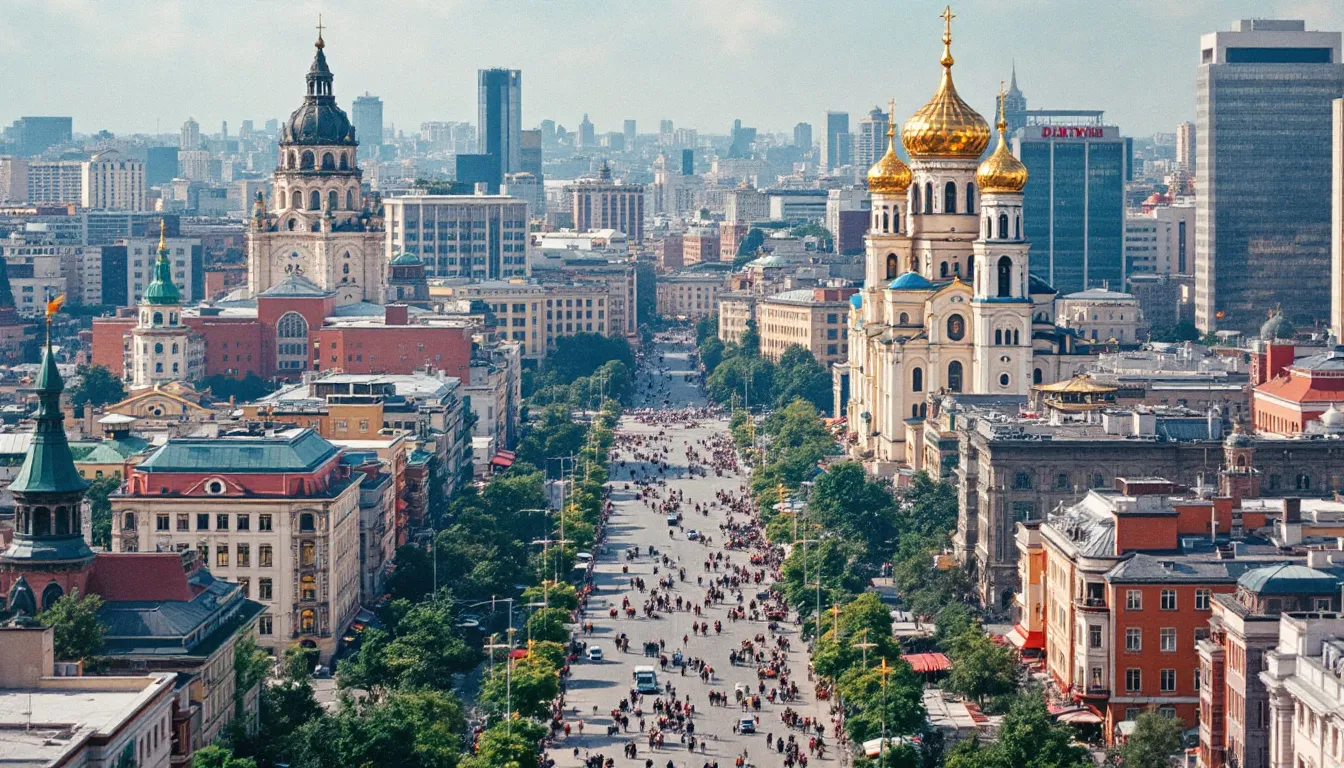
What is the Largest Country in Europe? A Comprehensive Overview
Share
When asking ‘what is the largest country in Europe,’ the answer is Ukraine. Covering about 603,550 square kilometers, Ukraine stands as the largest country entirely within the continent. This article explores Ukraine’s geographical, historical, and economic significance.
Table of Contents
Key Takeaways
- Ukraine is the largest country in Europe by land area, covering approximately 603,550 square miles and playing a vital role in the continent’s agricultural sector.
- The country features diverse geographical boundaries, including the Black Sea and Carpathian Mountains, which enhance its geopolitical significance and ecological diversity.
- Ukraine’s strategic location and its ambitions for EU integration underscore its importance in European politics and economy, contributing substantially to agricultural exports and receiving significant financial support from the EU.
The Largest Country in Europe: Ukraine
Among all the European countries, Ukraine stands tall as the largest countries by land area, encompassing approximately 603,550 square miles. This vast expanse includes a diverse range of geographical features, from fertile plains known as the ‘breadbasket of Europe’ to the majestic Carpathian Mountains. Unlike other transcontinental countries that straddle Europe and Asia, such as Russia and Turkey, Ukraine is fully situated within Europe’s total area, which can comprise European France. This distinction places Ukraine in a unique position, separating it from the likes of Russia, which has significant portions in Asia, or Turkey, which spans both continents, unlike those in other continent.
Ukraine’s economy is a cornerstone of Europe’s agricultural sector, contributing 10.9% of its GDP in 2021. Its vast land area and agricultural output make it an essential player in feeding the continent, solidifying its status as both a geographical and economic giant in Europe.
Exploring Ukraine’s geographical and historical context, most geographers note that major cities, regions, and natural landscapes reveal the multifaceted reasons behind its prominence in southern europe.
Geographical Boundaries of Ukraine
Ukraine’s geographical boundaries are defined by a fascinating array of natural features and historically significant landmarks. To the south, Ukraine is bordered by the Black Sea, providing not only a natural boundary but also a crucial maritime gateway. The Sea of Azov, although smaller, also plays a significant role in Ukraine’s maritime borders. Historically, the country’s boundaries have been marked by the Black Sea, the Kerch Strait, and the Don River, which have served as traditional geographical markers.
These natural features connect Ukraine to various regions, establishing a border with Asia through the Ural Mountains and the Caspian Sea. This strategic positioning places Ukraine at a crossroads between Central Europe, Eastern Europe, Central Asia, and western asia, enhancing its geopolitical significance.
Ukraine’s geographical boundaries make it a bridge between Europe and Asia, highlighting its role in the region’s historical and contemporary dynamics at the europe asia border place and the eastern boundary.
Historical Context
The historical context of Ukraine is a tale of shifting borders and evolving identities. During the 18th and 19th centuries, the emergence of powerful nation-states in Europe, such as the unification of Italy and Germany in 1871, marked significant shifts in the political landscape. Similarly, Ukraine’s history has been shaped by the rise and fall of empires, including the Byzantine Empire, which was a dominant force in Europe for centuries.
These historical shifts have profoundly influenced Ukraine’s territory annexed dynamics and modern-day boundaries, contributing to its rich human history and complex identity.
Appreciating Ukraine’s status as Europe’s largest country and its significant historical role requires understanding this rich context.
Ukraine's Major Cities and Regions

Ukraine’s urban landscape is a testament to its cultural and economic diversity. With 461 officially recognized cities, Ukraine boasts a significant urban population, according to official figures and total figures. These cities are not just population centers but are also hubs of cultural and economic activity.
From the bustling capital of Kyiv to the industrial heart of Kharkiv and the historic charm of Lviv, each city contributes uniquely to the nation’s identity. Exploring these major cities and regions reveals the distinct characteristics that integrate them into Ukraine’s cultural and economic fabric.
Kyiv: The Capital City
Kyiv, the capital of Ukraine, is a city that pulsates with life and history. As the largest city in the country, Kyiv is not only a political and economic hub but also a cultural epicenter. With a population exceeding 2.9 million as of 2022, Kyiv stands as a testament to Ukraine’s resilience and growth. The city is home to significant national institutions, including the government and major cultural landmarks, making it the heart of the nation.
Kyiv’s streets showcase a blend of history and modern life, featuring historic churches, bustling markets, and modern skyscrapers that reflect a vibrant cultural heritage and forward-looking spirit.
As the capital, Kyiv shapes Ukraine’s political and cultural landscape, underscoring its immense significance.
Other Major Cities
Beyond Kyiv, Ukraine is home to several other major cities that play crucial roles in the nation’s cultural and economic landscape. Kharkiv, the second-largest city, is a major industrial center with a population exceeding 1.4 million. The city’s industrial might and educational institutions make it a key player in Ukraine’s economic framework.
Odesa, located on the Black Sea, is another significant city known for its maritime trade and vibrant cultural scene. With a population of around 1 million, Odesa’s port facilities make it a critical hub for international trade.
Lviv, with its population of approximately 717,000, is renowned for its cultural heritage and historic architecture. Each of these cities contributes uniquely to Ukraine’s identity, underscoring the nation’s urban diversity and economic vitality.
Key Regions
Ukraine’s key regions are as diverse as its cities, each with its own unique characteristics and contributions. The Donbas region, known for its industrial output, especially in coal and steel production, is a vital part of Ukraine’s economy. This region’s rich coal resources and industrial activities have long been a cornerstone of Ukraine’s economic strength.
Crimea, with its unique geographical features, including mountains and a subtropical climate, stands out as a region of both strategic and cultural significance, distinct from other territory and internationally recognized. The Carpathian region, known for its picturesque landscapes and biodiversity, enhances the country’s ecological richness.
These historically defined regions highlight Ukraine’s geographical and economic diversity, showcasing its varied landscapes and significant contributions.
Ukraine's Natural Landscapes

Ukraine’s natural landscapes are a symphony of diverse topographies, ranging from sprawling plains to towering mountains and serene coastlines. The country’s landscape features a mix of plains, highlands, and mountains, creating a rich ecological tapestry. Bordered to the south by the Black Sea and the Sea of Azov, Ukraine’s geographical diversity enhances its ecological and economic significance.
As we explore the Carpathian Mountains, the Black Sea coastline, and the fertile plains, we will uncover the world’s natural beauty and ecological importance of these landscapes and lands.
Carpathian Mountains
The Carpathian mountain ranges, traversing western Ukraine, form one of the most picturesque and ecologically rich regions in the country. These mountains form a natural border with neighboring countries and host diverse flora and fauna. The highest peak in the Carpathian Mountains is Mount Hoverla, which rises to 2,061 meters, offering breathtaking views and challenging trails for adventurers.
The Carpathian Mountains symbolize Ukraine’s natural beauty. The region’s biodiversity and scenic landscapes attract tourists and nature enthusiasts from around the world. The mountains also play a crucial role in influencing the local climate, making this region a vital ecological zone in Ukraine.
Thanks for visiting our blog, are you planing to travel to Europe? Check out our eSIM Europe.
Black Sea Coastline
Ukraine’s coastline along the Black Sea stretches approximately 2,782 kilometers, providing critical access for trade and tourism. This coastline is significant not only for its length but also for its biodiversity and economic activities. The Black Sea coastline supports a variety of marine life and is a vital area for fishing and tourism, contributing to the local and national economy.
The biodiversity of the Black Sea coastline plays a crucial role in sustaining ecological balance. The region’s unique marine ecosystems are home to a variety of species, making it an area of significant ecological importance. The coastline’s economic activities, including maritime trade and tourism, underscore its importance in Ukraine’s economic framework.
Fertile Plains
The fertile plains of Ukraine are often referred to as the ‘breadbasket of Europe’ due to their high agricultural productivity. Covering an agricultural area of 41.3 million hectares, Ukraine is recognized as the largest agricultural nation in Europe. These plains, rich in chernozem soil, support extensive agriculture and diverse crops.
As one of Europe’s largest grain exporters, Ukraine significantly impacts the region’s agricultural economy. The productivity of these fertile plains plays a vital role in feeding not only Ukraine but also other countries in Europe and beyond. The agricultural output of these plains underscores Ukraine’s role as a key player in the global agricultural market.
Ukraine's Climate and Environment
Ukraine experiences a diverse climate, predominantly temperate, with Mediterranean conditions present in the Southern Coast of Crimea. This climatic diversity contributes to the country’s rich agricultural output and ecological variety.
Exploring the different climate zones and environmental challenges deepens our understanding of Ukraine’s climate and its environmental impact.
Climate Zones
Ukraine’s climate zones vary from temperate in most parts to Mediterranean in the southern regions, particularly in Crimea. The average annual temperature ranges between 7-9°C, with summer temperatures between 18°C and 22°C, making it suitable for various agricultural activities. The Carpathian Mountains in the west significantly influence the climate and ecological balance of the region.
Precipitation in Ukraine is mainly during summer, especially in June and July. The Carpathian Mountains influence local weather patterns and contribute to the region’s ecological diversity. Appreciating the country’s agricultural productivity and ecological richness requires understanding these climate zones.
Environmental Challenges
Like many countries around the world, Ukraine faces significant environmental challenges. Pollution is a major issue, affecting air quality and water resources, which in turn impacts public health and the environment. Industrial activities, particularly in regions like Donbas, contribute significantly to pollution levels, necessitating urgent attention and remediation efforts.
Deforestation is another critical challenge, posing threats to Ukraine’s rich biodiversity and natural landscapes. The loss of forests impacts not only wildlife habitats but also contributes to climate change, which in turn exacerbates environmental issues. Tackling these challenges is vital for sustaining Ukraine’s natural resources and the well-being of its inhabitants.
Ukraine's Role in Europe
Ukraine’s strategic location in Eastern Europe, bordered by countries such as Poland, Romania, and Hungary, positions it as a key player in the region. Since declaring independence from the Soviet Union in 1991, Ukraine has navigated a path towards greater integration with Europe. Its official candidate status for EU membership as of June 2022 reflects its aspirations to strengthen ties with the European Union and its commitment to European values.
This journey highlights Ukraine’s evolving role in Europe and its strategic importance in the continent’s political landscape.
Economic Contributions
Ukraine’s economic contributions to Europe are substantial, particularly in the agricultural sector. In 2023, Ukraine accounted for over 51% of wheat exports to the European Union, underscoring its role as a vital food supplier. This agricultural prowess not only supports Europe’s food security but also bolsters Ukraine’s economy.
The European Union has recognized Ukraine’s importance, providing substantial financial support to aid its economic stabilization and reforms. Since 2014, the EU has allocated over €17 billion in grants and loans to Ukraine. Additionally, in response to the conflict that began in 2022, the EU and its member states have provided nearly €108 billion in support, highlighting the critical role Ukraine plays in the region.
These economic contributions and support mechanisms underscore Ukraine’s integral role in the European economy.
Political Influence
Ukraine’s political influence in Europe is significant, particularly in light of its strategic regions. Crimea, with its unique landscapes and historical sites, holds considerable geopolitical importance. The annexation of Crimea by Russia in 2014 has had profound implications for regional security and international relations.
The Donbas region, known for its coal mining, also plays a crucial role in Ukraine’s political landscape. The ongoing conflict in this region has highlighted the strategic importance of Ukraine in European security dynamics.
These geopolitical factors underscore Ukraine’s influence and the critical role it plays in shaping the political landscape of Europe.
Ukraine, the largest country in Europe by land area, is a nation of immense geographical, historical, and cultural significance. Its vast landscapes, from the fertile plains to the Carpathian Mountains and the Black Sea coastline, contribute to its ecological richness and economic vitality. Major cities like Kyiv, Kharkiv, Odesa, and Lviv, along with key regions such as Donbas and Crimea, highlight the nation’s cultural diversity and economic contributions.
As Ukraine continues to navigate its path towards greater integration with Europe, its role as a strategic and influential player in the region becomes increasingly evident. The challenges it faces, particularly in environmental sustainability, underscore the need for continued support and collaboration with European partners. Ukraine’s story is one of resilience, growth, and an unwavering commitment to its place in the European tapestry. Embracing this journey offers a deeper appreciation of Ukraine’s contribution to Europe and the world.
Before you take off make sure to check with local government of the travel status.
Frequently Asked Questions
What is the largest country in Europe by land area?
The largest country in Europe by land area is Ukraine, which spans approximately 603,550 square miles.
What are the major geographical features of Ukraine?
The major geographical features of Ukraine encompass the Black Sea, the Carpathian Mountains, and extensive fertile plains. These elements are integral to the country's landscape and agricultural productivity.
How does Ukraine's history influence its current boundaries?
Ukraine's history, marked by the impact of various empires and pivotal events, greatly influences its present boundaries. The legacy of these historical influences is evident in the cultural and geopolitical landscape of modern Ukraine.
What are some key cities and regions in Ukraine?
Key cities in Ukraine comprise Kyiv, Kharkiv, Odesa, and Lviv, while important regions include Donbas, Crimea, and the Carpathian region. These areas are vital to the country's cultural and economic landscape.
What are the main environmental challenges Ukraine faces?
Ukraine grapples with major environmental challenges such as pollution and deforestation, adversely affecting biodiversity and public health. Addressing these issues is crucial for the country's ecological and social well-being.








